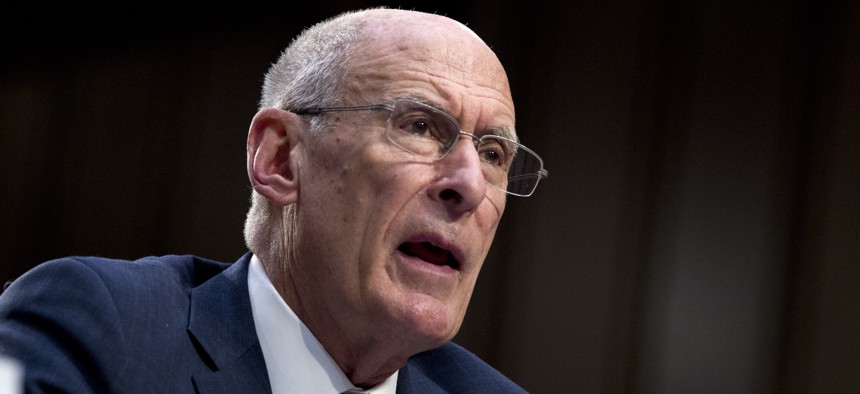
Director of National Intelligence Daniel Coats testifies before the Senate Intelligence Committee on Capitol Hill in Washington Tuesday, Jan. 29, 2019. AP / Jose Luis Magana
Intelligence Chiefs Diverge From Trump On Main Threats to US
The things that worry America’s intelligence community can’t be stopped by a wall.
U.S. intelligence heads went to Capitol Hill on Tuesday and described the threats facing America in terms quite different from those offered by the White House.
North Korea is still committed to developing nuclear missiles. ISIS, though weakened, still commands thousands of fighters. China’s reach into the global telecommunications industry presents an intelligence and security concern. Russia continues to sow disinformation to undermine the United States and its allies. It was a list of security problems that defied easy solutions. Agency heads and lawmakers seemed unsure what to do about the disconnect, besides talking more in a closed session.
The issue of North Korea provided the starkest disconnect between the intelligence community and the White House. Emerging from list June’s unprecedented summit with leader Kim Jong Un, President Donald Trump triumphantly declared, “There is no longer a Nuclear Threat from North Korea.” The president has since curbed his boasts — yet speaking to the United Nations in September, still tried to paint North Korea’s cessation of missile testing as evidence of a reduced threat. (Pyongyang has said that their ICBMs are now reliable enough to need no further tests.)
On Tuesday, Dan Coats, director of the Office of National Intelligence, described the situation in terms that sounded more like what the world was saying before to the Trump-Kim Summit.
“North Korean leaders view nuclear arms as critical to regime survival,” Coats said in his testimony. The intelligence community “continues to assess that it is unlikely to give up all of its WMD stockpiles, delivery systems, and production capabilities.”
CIA Director Gina Haspel confirmed that: “The regime is committed to developing a nuclear, long-range armed missile that would pose a direct threat to the United States.” Almost by way of a consolation prize, she offered that “It is positive that we have managed to engage them in a dialogue.”
Coats painted a grim picture of the conflict with ISIS, which continues to command thousands of fighters in Iraq and Syria. The group maintains eight branches, a dozen-plus networks, and followers around the world. In his written testimony, he highlighted the danger of a precipitous troop withdrawal from Syria, albeit indirectly. “The group will exploit any reduction in [counter-terrorism] pressure to strengthen its clandestine presence and accelerate rebuilding key capabilities, such as media production and external operations. ISIS very likely will continue to pursue external attacks from Iraq and Syria against regional and Western adversaries, including the United States,” he wrote.
Haspel added that the territorial victories against ISIS in Syria could prove short-lived. She said hundreds of foreign fighters from ISIS remained in the custody of the Syrian government, in a sort of limbo state beyond U.S. influence. "I think it would be very bad" if they were released, she told Sen. Tom Cotton, R-Ark.
Coats wrote that China and Russia, which play starring roles in the Defense Department’s National Defense Strategy as America’s main competitors, are growing closer than ever. They are “more aligned than at any point since the mid-1950,” much to Washington’s discomfort, he said.
Trump, who publicly solicited a Russian hacking operation against his opponent in his 2016 presidential campaign, has historically vacillated between denying the U.S. intelligence community’s January 2017 conclusion that Russia ran information and misinformation campaigns in the United States, and attempting to minimize it. During his July 2018 summit with Putin, the U.S. president pushed back on his intelligence community’s assessment. He deferred to Putin who "just said it is not Russia,” and added “I don't see any reason why it would be…President Putin was extremely strong in his denial today." (He later said that he had said “would not.” The tape and the context of his remarks suggest otherwise.)
On Tuesday, intelligence leaders reaffirmed their high-confidence assessment that Russia was indeed behind the DNC and Podesta hacks in 2015 and 2016 and the subsequent information campaign. They also concluded that the activity was likely to continue. “They are now becoming more adept at using social media to alter how we think, behave, and decide,” Coats testified, adding that “Russia’s social media efforts will continue to focus on aggravating social and racial tensions, undermining trust in authorities, and criticizing perceived anti-Russia politicians.”
Coats' written statement also describes China’s growing cyber capabilities. “Beijing will authorize cyber espionage against key US technology sectors when doing so addresses a significant national security or economic goal not achievable through other means. We are also concerned about the potential for Chinese intelligence and security services to use Chinese information technology firms as routine and systemic espionage platforms against the United States and allies,” he wrote.
While that shouldn’t be controversial, it has become so under Trump, who has come to the defense of Chinese telecom company ZTE.
At one point, Cotton asked the witnesses to raise their hands if they would recommend buying a ZTE phone. No hands rose.
The one security threat that the White House does routinely emphasize, that of people coming across America’s southern border, received little airtime. It takes up just a sentence in Coats’ testimony: “Gangs based in Central America, such as MS-13, continue to direct some criminal activities beyond the region, including in the United States.”




